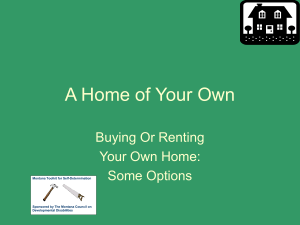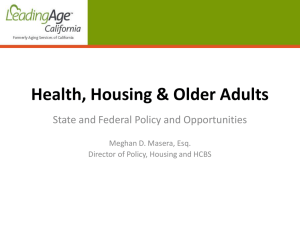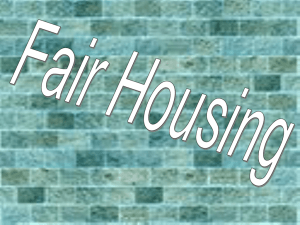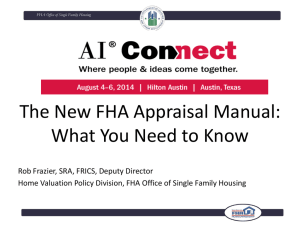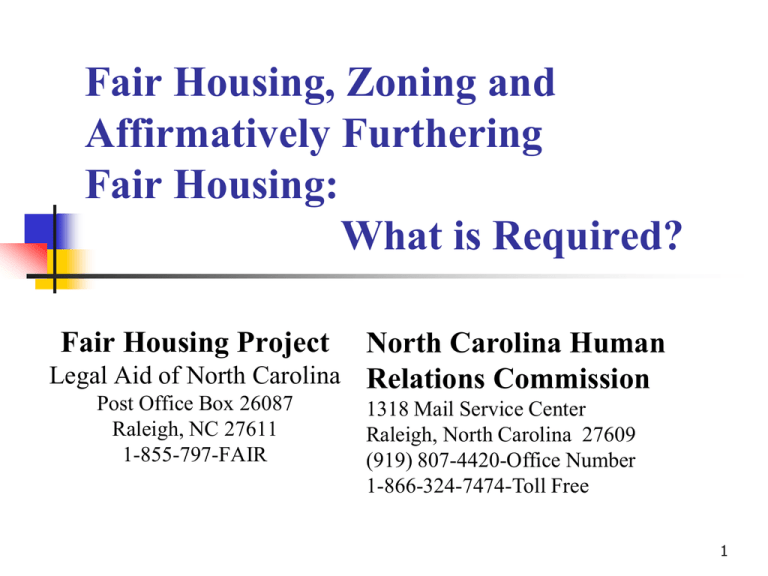
Fair Housing, Zoning and
Affirmatively Furthering
Fair Housing:
What is Required?
Fair Housing Project
North Carolina Human
Legal Aid of North Carolina Relations Commission
Post Office Box 26087
Raleigh, NC 27611
1-855-797-FAIR
1318 Mail Service Center
Raleigh, North Carolina 27609
(919) 807-4420-Office Number
1-866-324-7474-Toll Free
1
The work that provided the basis for this publication was
supported by funding under a grant with the U.S. Department of
Housing and Urban Development. The substance and finding of
the work are dedicated to the public. The author and publisher
are solely responsible for the accuracy of the statements and
interpretations contained in this publication. Such
interpretations do not necessarily reflect the views of the
Federal Government.
The material in this presentation is for information and
educational purposes only and does not constitute legal advice.
2
Fair Housing: Federal Laws
Fair Housing Act
Civil Rights Act of 1866
42 U.S.C. §5309
Americans with Disabilities Act (ADA)
42 U.S.C. §2000d, et seq.
Sec. 109, Housing & Comm. Dev. Act of 1974
42 U.S.C. § 1981
Title VI of Civil Rights Act of 1964
42 U.S.C. §3601, et seq.
42 U.S.C. §1201, et seq.
Sec. 504, Rehabilitation Act of 1973
29 U.S.C. §794
3
Fair Housing: State Law
North Carolina State Fair Housing Act
N.C. Gen. Stat. §41A-1
added Affordable Housing as protected class
4
Fair Housing Act
FHA passed April 1968
Context
De jure racial discrimination in housing
Housing segregation based on race
Civil Rights Movement
Kerner Commission (1968)
“our nation is moving toward two societies, one
Black, one white – separate and unequal”
5
FHA Goals
Non-discrimination based on 7 “protected
classes”
Race, color, religion, national origin, sex,
disability, familial status
Ending segregation
Originally focused on racial & national origin
6
Affirmatively Furthering Fair Housing:
HUD Obligations
HUD required to administer programs “in a
manner affirmatively to further the policies”
of the Fair Housing Act
42 U.S.C. §3608(e)(5)
HUD has obligation “to do more than
simply refrain from discriminating;” must
also “assist in ending discrimination &
segregation”
NAACP v. Sec. of HUD, 817 F.2d 149 (1st Cir. 1987)
7
Affirmatively Furthering Fair Housing:
Grantee Obligations
CDBG grants “shall be made only if the grantee
certifies” that
the grant will be conducted and administered in
conformity with” the FHA
“the grantee will affirmatively further fair housing.”
42 U.S.C. §5304(b)(2)
Also applies to HOME, Emergency Shelter Grant,
NSP funds
Applies to subgrantees/subrecipients
8
AFFH: What is Required?
No regulatory definition of AFFH
HUD Fair Housing Planning Guide
3 General Requirements:
Conduct Analysis of Impediments to Fair Housing
Choice (AI) study
Take appropriate actions to overcome effects of any
impediments identified
Maintain records reflecting analysis & actions taken
www.hud.gov/offices/fheo/images/fhpg.pdf
9
AFFH: What is Required?
HUD Fair Housing Planning Guide
Affordable housing vs. fair housing activities
Not enough to build or rehab low/mod housing
Primarily symbolic activities not enough
E.g. FH poster contests
10
U.S. ex rel. Anti-Discrimination Center
v. Westchester County
False Claims Act
Allows private party to sue in place of US
government
Remedies
Treble damages
Attorney’s fees
Injunctive relief
11
ADC v. Westchester:
Plaintiff’s Allegations
County received > $52 million from 2000-06
County certified meeting AFFH obligations
County did not meet AFFH
AI did not ID any impediments based on race,
color, national origin
AI did not mention housing discrimination or
segregation
12
ADC v. Westchester:
County’s Response
Race is not required to be considered
Income is a better proxy than race for
determining needs
Race is “not among the most challenging
impediments” in County
13
ADC v. Westchester:
Settlement Agreement
County to develop 750 affordable units
660 in predominantly white cities
County acknowledges it can sue cities who resist
Conduct new AI to comply w/ Planning Guide
HUD Monitor to oversee compliance
Return $30 million to HUD
<3% African American and <7% Latino
$7.5 million to ADC
Supply additional $30 million for integrative units
Pay $2.5 million attorney’s fees & costs
14
Holding Local
Governments Accountable
Examples of Local FH Activities
Updating local FH laws w/ add’l protected classes
e.g. affordable housing as protected class
Supporting accessibility & visitability
Training for City staff, officials, landlords & general public in FH
law & diversity
Education & outreach to promote FH, knowledge of LL/tenant
laws & awareness of disparate impact of certain policies (e.g.
criminal background screening)
Establishing FH complaint processes
Affirmative marketing
Ensuring Land use, zoning, occupancy codes are FH compliant
FH testing
15
ADC v. Westchester:
Implications for CDBG Recipients
Review your AI
Make sure up-to-date (last 5 yrs.)
Addresses all protected classes, including race, color &
national origin
Involve local community & groups
Address segregation in addition to discrimination.
Include specific actions to address barriers to FH.
Hold sub-recipients accountable
Cities, towns, etc. must also AFFH
16
Federal Fair Housing Act
What Type of
Property is
Covered?
Who is Protected?
What Actions are
Prohibited?
17
Types of Property Covered
The FHA broadly applies to "dwellings,” which
includes almost every residential rental unit.
Single and Multi-family housing
houses, apartments & condos
Group homes
Shelters
Migrant housing
Assisted living housing
Long-term transient lodging
18
FHA Dwelling Exemptions
Rental of a single family home without a broker or
advertising.
Units in an owner-occupied building having no
more than four families living independently of
each other.
Private clubs may provide noncommercial lodging
for their members.
Religious organizations may limit or give
preference to persons of the same religion in
noncommercial dwellings.
19
Who is Protected?
Race
Color
National Origin
Sex / Gender
• Includes sexual harassment
Religion
Familial Status (1988)
Disability (1988)
20
Fair Housing Applies to Zoning
The FHA prohibits a broad range of activities,
including restrictive zoning.
As a result, zoning boards, municipalities, and
other gov’t entities that take actions in violation of
the FHA will be liable.
21
Legislative Intent of FHA
“The Committee intends that the prohibition against
discrimination against those with handicaps apply to
zoning decisions and practices. The Act is
intended to prohibit the application of special
requirements through land-use regulations,
restrictive covenants, and conditional or special use
permits that have the effect of limiting the ability of
such individuals to live in the residence of their
choice in the community.” H. Rep. No. 100-711, at
24 (1988).
22
Policies Underlying FHA &
Zoning
Increase housing opportunities for people
with disabilities
Integrate people with disabilities into
mainstream (i.e., community) settings
23
What Type of
Discrimination is Illegal?
Intentional discrimination
Discriminatory classification
of people w/ disabilities
Zoning Laws w/ disparate
impact
Failure of local gov’t
officials to reasonably
accommodate people w/
disabilities
24
Disability: Definition
Physical and / or mental impairment which
substantially limits 1 or more major life
activities, or
Record of having such impairment, or
Being regarded as having such impairment
Includes people associated with or residing
with person meeting definition
25
Disability: Examples
Mobility impairments
Sensory impairments
Mental illness
HIV positive or AIDS
Former drug abuse
Other physical / mental
impairments
26
Reasonable Accommodations
Changes in “rules, policies, practices, or services
when … necessary to afford … equal opportunity to
use & enjoy dwelling”
Can require proof of covered disability
Change must be related to disability
Can be requested at any time
Not “reasonable” if “undue burden” on housing
provider or “fundamental alteration” of provision of
housing
27
Reasonable Accommodations
& Zoning
FHA mandates that zoning officials “change,
waive, or make exceptions in their zoning
rules to afford people with disabilities the
same opportunity to housing as those who
are without disabilities.”
Hovsons Inc. v. Township of Brick,
89 F.3d 1096, 1104 (3d Cir. 1996).
28
Reasonable Accommodations:
Examples
Allow nursing home to operate in mixed
residential zone
Waive minimum side yard requirement
Variance to allow facility for people with
disabilities in commercial/industrial district
Allow 8-person home (vs. 6-person)
Exception to dispersion requirement
29
Exceptions
Direct Threat. The FHA does not require a
tenancy that would be a “direct threat” to the
health or safety of other individuals, or result in
substantial damage to the property of others,
unless a reasonable accommodation could
eliminate the threat.
Drug use. The current use of illegal drugs is
excluded from the definition of disability.
30
What Acts are Prohibited?
•
Refusal to sell, rent,
negotiate, or “otherwise
make unavailable or deny”
a dwelling
Discriminate in the terms,
conditions, or privileges of
sale or rental of a
dwelling, or in the
provision of services or
facilities
31
What Acts are Prohibited?
Coerce, intimidate, threaten, or
interfere with a person’s right to
fair housing
Attempts by local gov’ts to interfere
with group homes may give rise to
liability
32
Intentional Discrimination:
Examples
Denial of special use permit for a halfway house for
recovering alcoholics, where decision-makers statements show
that the decision was based on the identity of the residents and
legitimate reasons for denial were deemed pretextual
Moratorium on new adult care facilities w/o justification
Limitation on geographical proximity, where limitation was
imposed in response to community fears and concerns about
property values
Denial of renovations permit based on objections to residents
of the group home
33
Intentional Discrimination:
Examples (cont’d)
Requiring a zoning application for a special exception to
provide a residence for people who are HIV-positive was
deemed to be intentional discrimination, in part because the
residence met the town’s zoning criteria for “family” residence
and zoning officials departed from normal procedures in
considering the issue
Treatment of a group home for people with disabilities as a
“treatment facility” rather than a “family” (even though it met
the definition), due to widespread community opposition
34
Discriminatory Classifications:
Examples
Dispersion requirements mandating that group homes be a
particular distance apart
Application of fire code to group home for persons with
mental illness who had no problems evacuating
Conditioning group home permit on 24-hour supervision
and establishment of “community advisory committee”
Requiring certificate of occupancy for group home for
people with disabilities only (not for other group homes)
Requiring notice to neighbors of a group home’s existence
where not required for other residential units
35
Disparate Impact: Examples
Requiring group homes include only persons who
are mobile and capable of exiting a building and
following instructions
Dispersion requirement for group homes
“Program review board” requirement for group
home license
Limitation on # of unrelated persons allowed to
live together
36
Interference, Coercion, or
Intimidation: Examples
Denial of special use permit, where reason for
denial proven to be pretext
Weekly citations for noise, parking, zoning, etc.,
where town had been lax, plus evidence of
discriminatory statements
37
N.C. FAIR HOUSING ACT
N.C. Gen. Statutes Ch. 41A
Essentially mirrors Federal FHA:
Covers all Federal protected classes;
Applies to same properties and transactions;
Prohibits the same discriminatory acts.
In addition, 2009 amendments added another
protected class NOT covered by Fed. FHA
38
Adds affordable housing as a
protected class for land-use decisions
§ 41A-4(g) ”It is an unlawful discriminatory housing
practice to discriminate in land-use decisions or in the
permitting of development based on race, color, religion,
sex, national origin, handicapping condition, familial
status, or, except as otherwise provided by law, the fact
that a development or proposed development contains
affordable housing units for families or individuals with
incomes below eighty percent (80%) of area median
income. It is not a violation of this Chapter if land-use
decisions or permitting of development is based on
considerations of limiting high concentrations of
affordable housing.”
39
What It Means
Government bodies involved in land-use
planning and regulation cannot refuse
approval or otherwise discriminate against
proposals because they include affordable
housing.
At a minimum, this section covers decisions by zoning boards,
planning boards, county commissions and municipal councils.
Probably also applies to municipal utilities, highway and other
transportation planning, and soil and water districts.
40
What It Means (Cont’d.)
Affordable Housing is defined as housing
intended for families or individuals with
incomes less than 80% of median income in
the area.
Does not define the size of the area used to
determine median income (but based on HUD
definition, which uses MSA).
Does not state how to determine if housing is
“for” such families.
41
What It Means (still cont’d)
Allows land-use planners to limit “high
concentrations” of affordable housing.
Doesn’t define “high concentrations.”
42
What It Doesn’t Mean
Does not mean affordable housing
development must be approved.
Does not mean wealthy and poor
neighborhoods must receive identical
services, such as water & sewer.
Does not mean new developments must
include affordable housing.
Landlords do not have to accept Section 8
vouchers or other housing subsidies.
43
What We Don’t Know
Who can bring suit (standing).
FHA states “any person injured by a
discriminatory practice” may sue.
Standing under the FHA is usually
construed broadly to allow people to bring
suit, but does not stretch infinitely.
For purposes of its investigations, NCHRC
will construe standing broadly until
otherwise instructed by the courts or
legislature.
44
What We Don’t Know (Cont’d.)
How will courts define “area”, “for” poor
families, and “high concentrations”?
How will this affect political questions such
as annexation and boundary lines?
45
Statute of Limitations
Federal Act:
1 year from date of last act to file a
HUD complaint
2 years from date of last act to file a
lawsuit
Filing a complaint with HUD stops the
running of the time to file a lawsuit
under the federal and state Fair
Housing Act
46
Questions?
Fair Housing Project
Legal Aid of NC
1-855-797-FAIR
FAX 919-714-6925
This seminar provides
general information. For
legal advice, please consult
an attorney.
47

